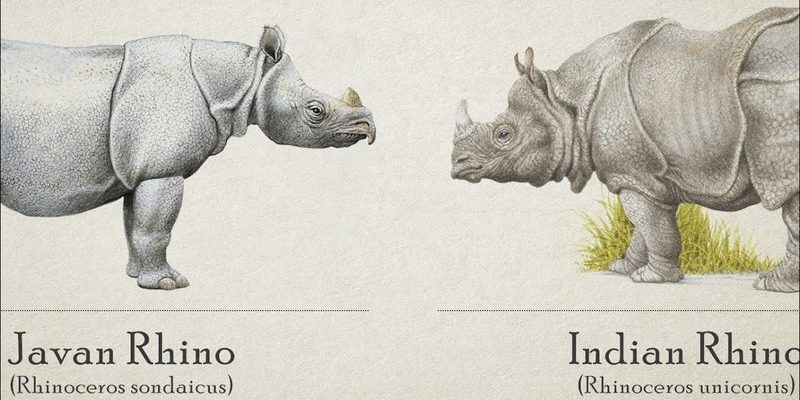![Comparing The Indian Rhinoceros Vs. [Similar Species]](https://gudri.com/wp-content/uploads/2025/06/Comparing_The_Indian_Rhinoceros_Vs___Similar_Species__image_0.jpg)
The Indian rhinoceros, known for its single horn and big size, roams the grasslands and forests of India and Nepal. It’s like the gentle giant you’d want to befriend—calm but powerful. On the other hand, the black rhinoceros is more like the rebellious younger sibling, smaller and a bit more aggressive, with two horns and a knack for navigating the thorny bushes of Africa. As we explore these two species, you might start to appreciate not just their differences, but also their roles in the ecosystem and the challenges they face today.
Physical Characteristics
When it comes to appearance, the Indian rhinoceros and the black rhinoceros each boast distinct features. The Indian rhino has a thick, skin-like armor made of folds, making it look almost prehistoric. Its skin is gray and can weigh up to 2,200 kg (4,850 lbs). Imagine a tank rolling through the grasslands—impressive and commanding attention. The gigantic single horn on its snout can grow up to 25 inches long.
In contrast, the black rhinoceros is a bit smaller, weighing around 800 to 1,400 kg (1,800 to 3,100 lbs). You might spot it more easily due to its two horns and pointed lips, which are perfectly shaped for grasping leaves and twigs from trees. If the Indian rhino is a tank, the black rhino is more like a nimble sports car—it’s built for agility and quick maneuvers through dense thickets.
Habitat and Distribution
Both the Indian and black rhinos thrive in different habitats. The Indian rhinoceros prefers the wetlands of northeastern India and Nepal. This environment is rich in tall grass, shrubs, and shallow water, making it a perfect spot for these animals to graze and bathe. You can often find them lounging in mud pits, which help keep their skin cool and protect them from pesky insects.
On the other hand, the black rhinoceros roams the dry, bushy savannas of eastern and southern Africa. These areas are often dotted with acacia trees, which are a major food source for them. Their adaptability allows them to thrive in harsher conditions, but this also makes them more vulnerable to poaching. The landscapes they call home differ significantly, highlighting how each species has evolved to fit its environment.
Behavior and Diet
Here’s the thing: both rhinos have unique behaviors influenced by their diets and habitats. The Indian rhinoceros is mostly a solitary creature, often found grazing peacefully during the early morning or late afternoon. Its diet primarily consists of grass, leaves, and fruit, which it finds in the lush wetlands it inhabits. Imagine it as a serene giant, quietly munching on its surroundings without a care in the world.
Conversely, the black rhinoceros exhibits a more erratic behavior. They can be a bit more aggressive, especially when threatened. They also have a diverse diet, feeding on a mix of shrubs, leaves, and even the bark of trees. This versatility in eating habits allows them to adapt to various environments as they seek out food. You might say the black rhino has a “no-nonsense” approach to life, always on the lookout for its next meal.
Reproduction and Lifespan
Both species have fascinating reproductive habits. The Indian rhinoceros has a gestation period of around 15-16 months, which is quite lengthy. When a baby rhino is born, it can weigh around 50 kg (110 lbs) and is usually able to stand and walk shortly after birth. It’s heartwarming to think about a little rhino waddling alongside its mother in the grasslands, learning how to navigate the world.
The black rhinoceros, too, has a similar gestation period, but their young tend to stay with their mothers for up to three years. This extended parenting period allows the calves to learn essential survival skills in their often-dangerous environment. The mothers are very protective and will fiercely defend their young from threats. It’s a tough world out there for young rhinos, and that motherly instinct plays a crucial role in their survival.
Conservation Status
Conservation is a critical topic when discussing both the Indian and black rhinoceroses. The Indian rhino, while still considered vulnerable, has shown signs of recovery due to conservation efforts in India. Protected areas, like Kaziranga National Park, have helped their population increase. You might feel a spark of hope knowing that dedicated efforts are making a difference for this majestic species.
In stark contrast, the black rhinoceros is critically endangered, with population numbers declining due to poaching and habitat loss. Their horns are highly sought after in illegal markets, which has put immense pressure on their populations. Conservationists are working tirelessly to protect these animals, but it’s a long and challenging road ahead. It’s a vivid reminder of how interconnected our actions are with the survival of these incredible creatures.
So, what have we learned from comparing the Indian rhinoceros and the black rhinoceros? They may share the name “rhinoceros,” but they showcase incredible differences in their physical traits, habitats, diets, and behaviors. The Indian rhino stands out with its large, solitary presence in the wetlands, while the black rhino’s smaller, more agile silhouette adapts to the tough terrain of Africa.
Ultimately, both species are crucial to their ecosystems and face significant challenges ahead. Understanding these differences helps us appreciate not just what makes each rhino unique, but also the efforts needed to protect them. As we sip our coffee, let’s remember the importance of these magnificent creatures and the urgent need to ensure their survival for future generations. Every little bit of awareness counts in the fight against their decline.

